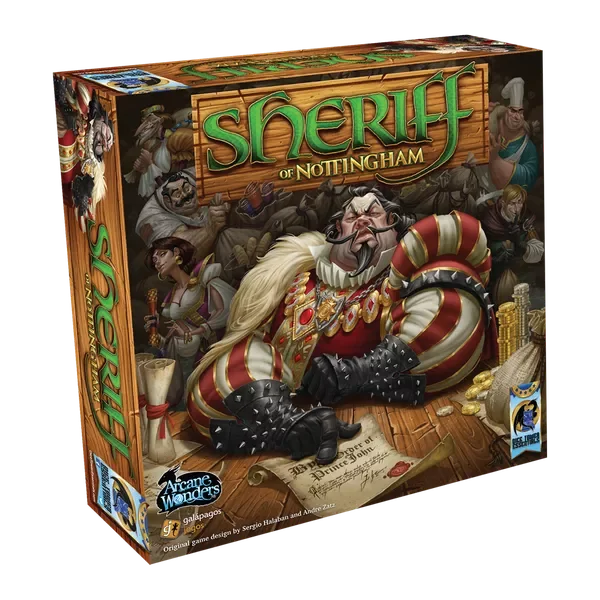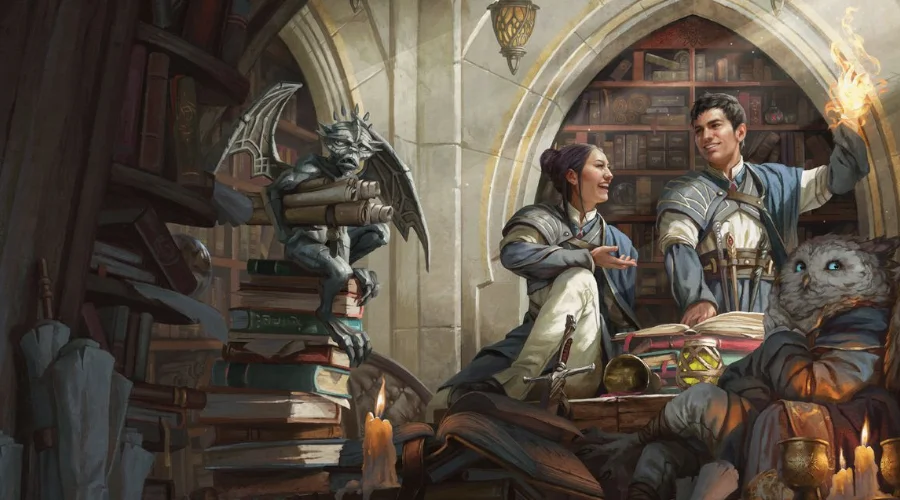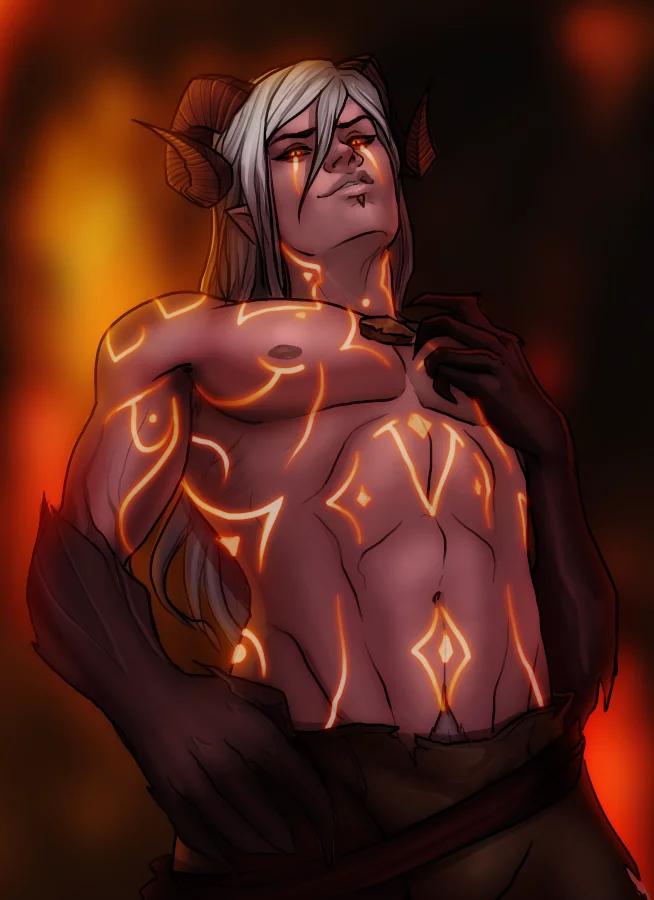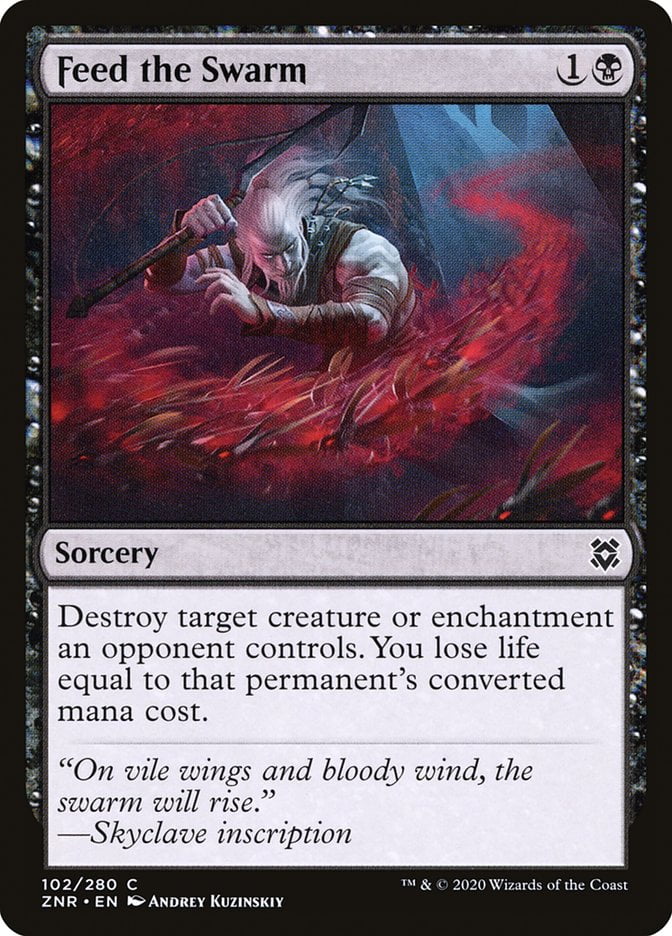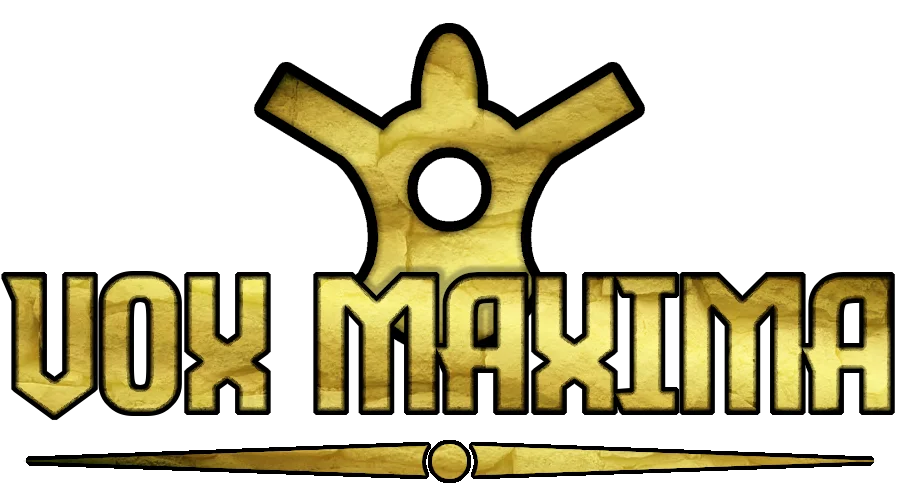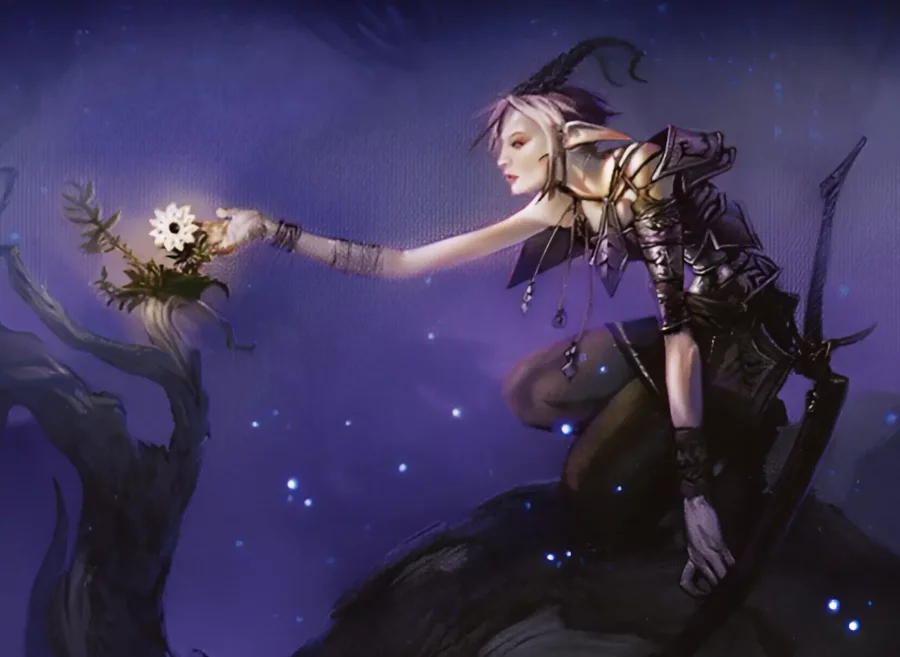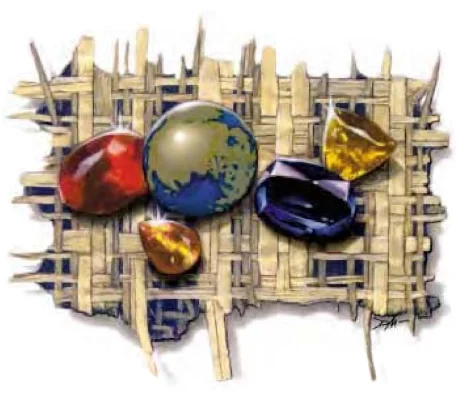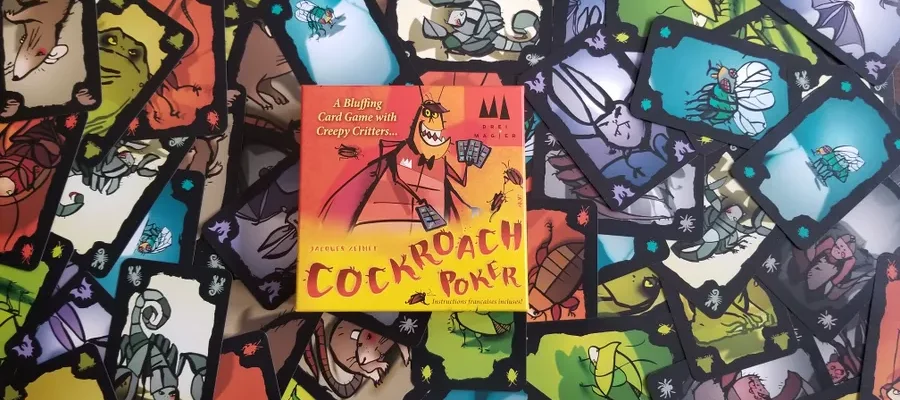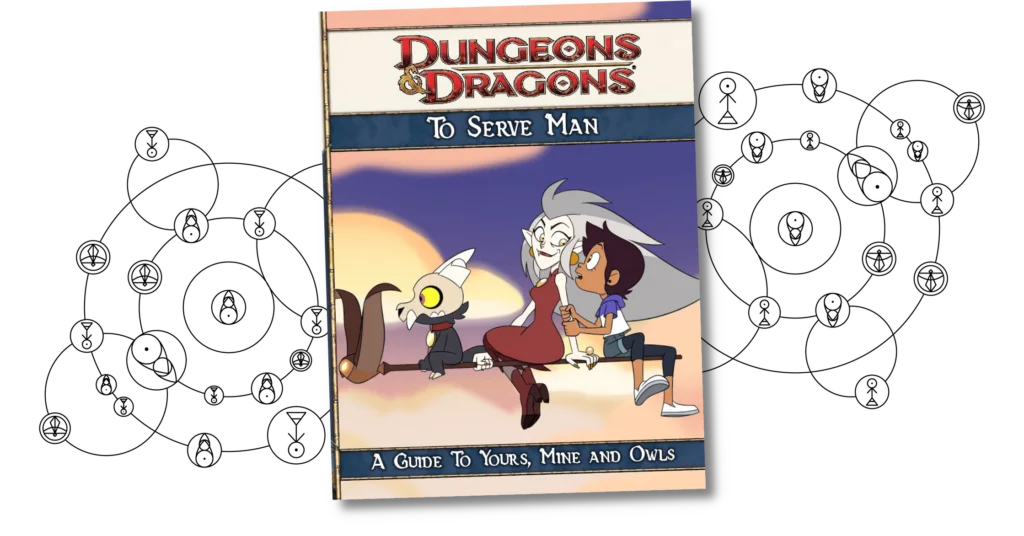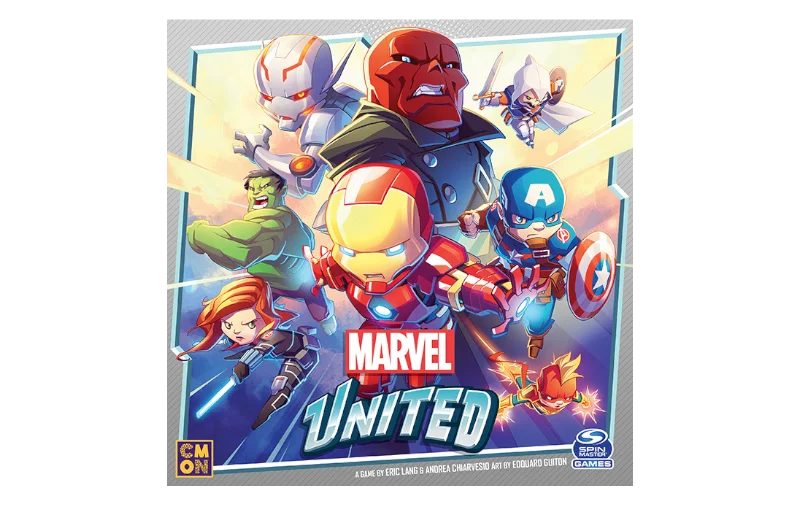Game Pile: Sheriff of Nottingham
Sheriff of Nottingham is one of my favourite games that I will probably never get to properly play.
Continue Reading →The Laewaes Dramaturgists
Arcane magic represents the most important discipline available to us in which people across all the world can come together to share our notes and experiences in order to construct a vision of how this system functions that is coherent and precise and replicable and also probably in some way, fundamentally wrong.
Archmagus Laewaes I
Look I just want to tell you about a cool adventure site and backstory hook from Cobrin’Seil that’s about something I care about a lot recently, which is a university system in-setting. It just takes a bit of a walk to get there because it involves understanding Arcane magic and how it differs from Divine magic, Primal Magic, and Psionics in the setting.
Continue Reading →Game Pile: Planetfall (Kinda)
Script and thumbnail below the fold!
Continue Reading →Well What if I Was In Charge Of Pokemon If I’m So Bloody Smart?
No matter where you are on the internet, whatever the fandom is, someone is always going to ask about what you’d do if you were in charge of it. For example, a lot of Bible fans are very convinced that their fanfiction is actually factually true. Whether it’s fantasy Wrestlemanias or ideal outfit compositions in Pretty Little Liars, there’s always an urge to take a thing you already know and make your version of it.
Also, people who like Pokemon routinely talk about what stupid idiots the designers are and how they could do a better job of running the game. I don’t think I could, because I know there are competing factors and I think that everyone who opens their mouth to talk like that sounds like a tool.
Still, if I think those people are silly, it’s easy to say that if I don’t put myself out there, right?
Here! A bunch of opinions about what I think should be done in Pokemon as a game franchise. Nothing like ‘open world matters’, I think the game should always be a competitive 2v2 Bo3 format and the rest of the game can follow from that. I also don’t think that this would make the game better. It’s very important that I put it out there, on my sleeve, that none of these changes are based on deep insight into the game or the way that it should be. No. This is a centering of myself, as a designer, and as a player of games. This is how I want it done. Also note that none of these changes are simple or oblative, like, this isn’t all that I think should happen, there would need to be specific changes and fine tuning for all these pushes.
There, preamble done, here’s how and where I’m right.
Continue Reading →3e: Objection to Formula
When I started on this article, the plan was to talk to you about the magic item system in D&D 3rd edition, and let’s put a pin in the word ‘system’ there. But engaging with it meant looking at a place in history and a realisation of how I’m not just talking about stuff from an earlier edition of D&D I’m talking to you about an earlier version of myself.
As long as there has been an online, it seems, I have wanted to make things and put them on there.
Continue Reading →Game Pile: Gazillionaire
In 1994, the videogame company Lavamind released the game Gazillionaire, which was in its purest form a sort of spreadsheet software with a random number generator built in. A bunch of trading companies kick off at the same point in time engaging in transport and trade. You go to a planet, which has its own weirdo economy and its own current supply and demand of goods, buy what you want, sell what you want, and head off to a new location to make a profit on those goods. There are all layers of complexity here, with things like warehousing and random events along the way, and every planet has its own specialised services and its own stock market you can use to invest in.
And it looks
like
this.
Continue Reading →Wip Assessment 1
I keep my files organised in directories on my hard drive, which is a thing the youths don’t do any more, because of woke. I even use silly tricks to handle how they’re organised. Did you know you can put a ! on the front of a directory name, which will ensure it’s always sorted to the top of the list, so if there’s some sort of universal toolset or template directory you want, you can use that to keep it up the top for easy access? These are useful tips for if you want to run the Windows version of Xtree Gold, which they call ‘Explorer’ to manage your files.
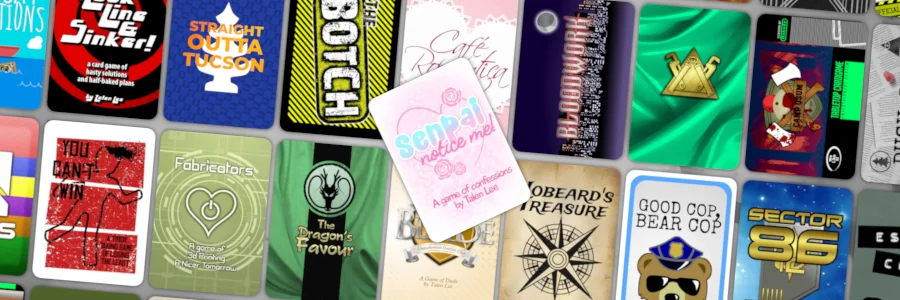
I keep my games in progress there. Hypothetically, that’s also where completed games go. I haven’t completed many games this year. Or last year. Or — look, it’s been rough since basically 2020, that’s when I can say for sure things got difficult. There have been a lot of reasons to slow down production, not the least of which is just money. Making games is a hobby and it costs money and I’ve just not had as much to play with lately. Shipping costs have changed, production costs have changed. I’ve talked about this before.
But those are why the game doesn’t get pushed to a product that I can sell you.
As of this moment I have 34 directories in my GameDev directory, with components of games of some degree or another, that are all labeleld as, in their own way, ‘WIP.’ Works in Progress. What are they waiting on? What is keeping the Works In Progress as In Progress?
Continue Reading →CoX: Bael
This is an explanatory writeup of one of my Original Characters (OCs). Nothing here is necessarily related to a meaningful fiction you should recognise and is shared because I think my OCs are cool and it’s cool to talk about OCs you make.
So he’s an incubus? Is that the word for a boy one?”
“Succubus and Incubus refer to ‘bottom’ and ‘top’, you know.”
“Whoah, really? Then which one is he?”
“I’m RIGHT HERE.
Bael really doesn’t like the word ‘sidekick.’ It hovered over him too long – first as a Demon Prince’s human-world emissary, then the caged pet of a Thorn mage, and finally as the protege of one of Paragon’s heroes. It was a tightly-packed few years.
Now the leader of the Young Spartans, Bael makes it his job to get the best out of his entire team.
Continue Reading →MTG: Black, Enchantments, and Black Enchantments
Bit of a two parter here, folks~! Since I’m playing more Magic: The Gathering thanks to Arena, I have decks I play around with. I want to think about the decks I’ve been playing with later, I want to look back and see what I thought of them, and that means, yep, using the blog as a history of my life. Like some kind of web-log. Anyway, what that means is I’m going to talk about a thing that I’m thinking about in Magic: The Gathering, then I’m going to talk about a deck I’ve been playing that reminds me of it the idea! Cool? Cool. Cool!
Anyway, I don’t like black enchantment hate.
In Magic: The Gathering, to be specific.
Continue Reading →Vox Maxima Story Spotlight 3 — The Million Eyes
What follows here is a discussion of what, if I had the means and writer tools to make my Custom Magic set have proper story spotlight material, it’d look like this, it’d be built out of this. This is basically about story mechanics underlying a game system, and I want to present it to you so you can have a handle on what it looks like when I’m trying to explain game narratives for the presentation of conventional narratives.
This third section indicates the midpoint of the story and the collapse of a lot of hopeful ideas; this is where the party meets with the Jatku Outcasts in their jungle fortress, and learns the horrible truths about the Necrocalypse, the Emperor, and the truth of the dead woman Jatku, mother to one of the Princesses.
Vox Maxima is a custom magic set created by Talen Lee. It’s composed of 187 cards, with 71 commons, 60 uncommons, 41 rares, and 15 mythic rares. Vox Decima is a custom Magic: The Gathering set, with at least one card spoiled a day, on Cohost, Kind.Social, and the r/custommagic subreddit.
WOTC Employees: This post in full presents unsolicited custom Magic: The Gathering card designs, which I understand current employee practices forbid you from looking at unsolicited. You shouldn’t be here!
Continue Reading →Vox Maxima Gallery 3: The Iacon Colleges
The Iacon Colleges represent the coalition of the finest magewrights, researchers and technician in the Kraivh Empire. The Empire is a place of faith and trust, but it is to the colleges they turn when they want to make their vaulted cathedrals and also sick sky skimmers. The Iacon Colleges represent a drive to understand the world that the Emperor is keeping safe, and the Iacon Colleges do so through rigorous study, abandonment of the unnecessary, and a kind of focus that could drive a mushroom through a solid concrete slab.
It is the Iacon College who first spoke of the coming disaster, it is the Iacon College that can find murky shards of lost history, it is the Iacon College whose great towering spires, near to the heart of the Empire, most closely align with the needs of the empire. Where a billion are lost, many of them are lost in the Colleges, and all they have left behind are parts and notes. The Iacon Colleges seek to remake their history, even if they have to time travel to do it.
Vox Maxima is a custom magic set created by Talen Lee. It’s composed of 187 cards, with 71 commons, 60 uncommons, 41 rares, and 15 mythic rares. Vox Decima is a custom Magic: The Gathering set, with at least one card spoiled a day, on Cohost, Kind.Social, and the r/custommagic subreddit.
WOTC Employees: This post in full presents unsolicited custom Magic: The Gathering card designs, which I understand current employee practices forbid you from looking at unsolicited. You shouldn’t be here!
Continue Reading →Game Pile: Negotiating Gender and Capitalism in Braid
Thumbnail below the fold! This is based on the script for my article from 2019, here.
Continue Reading →Why Is Druid?
Say that like ‘where is Wizard Hut?‘
I love the 4e Druid. This is a marked change from how much I liked the 3e druid, or how often you might see me playing a druid in a Baldur’s Gate game. Back in 3rd edition, the druid, despite being very powerful, never really engaged me, in part perhaps because I was always trying to find something exploitative and powerful rather than merely accepting the juggernaut of a toolkit the game just left in the Player’s Handbook. You couldn’t get clever with the Druid, you just had to pick it up and use it, like some sort of society of creative anachronisms where one of the anachronisms available to the players was has gun. Valid, but hardly sporting.
The Druid in 4th edition is different. Wildly different. Weirdly different, and different in one of those ways that shows what I think of as a seam in the design between 4th and 3rd editions of D&D.
Continue Reading →3e: Sticks and Stones
Alright I’m up late and the thing I was working on didn’t work and I don’t want to fall behind on my schedule so let’s just belt out something about the ongoing grievance I have in how 3rd edition D&D treated spellcasters as a better class of people with their own higher standard of living because being able to rewrite reality at will is by no means a perk enough to justify not feeling bummed out.
Let me talk to you about sticks and stones powers.
Continue Reading →Game Pile: Cockroach Poker
If you search my blog for this game, you will find mentions of it. You will find references to it, and discussions of it in the context of making games, redesigning mechanics, and even mentioned in an anime where they play Cockroach Poker. I own a copy of this game, and yet somehow I’ve never presented a Game Pile article on its own about this game.
It feels like I should have gotten to this before now, but describing Cockroach Poker almost feels like I’m diagramming a fractal. Come on, then, learn about some of the smallest and tightest Units Of Game you can get.
Continue Reading →Hecsenfore, Part 2
This article builds on the previous two articles about the formation and lived culture of the necrostate city Hecsenfore, in the setting of Cobrin’Seil. If you have questions, it’s probably answered there, to start with, and this article just jumps straight into describing more of the districts of the city and what life is like in them.
Continue Reading →Hecsenfore, Part 1
The previous article involved a long form discussion of the history and potential formation of a necrostate that could, hypothetically, in the future, integrate with the Eresh Protectorate. With all that preamble out of the way, this article presents the first part of the long-form writeup of the city state that is known by its name:
Hecsenfore
Coastal heavily urbanised independent city-state, The Land of White Ravens, the Graveless State, The Internal Labyrinth, The Obsession, The Eresh Outcast
Continue Reading →Hecsenfore, A Necrostate in Principle
There’s this quote, from The Great Dictator:
To those who can hear me, I say – do not despair. The misery that is now upon us is but the passing of greed – the bitterness of men who fear the way of human progress. The hate of men will pass, and dictators die, and the power they took from the people will return to the people. And so long as men die, liberty will never perish…
So long as men die, liberty will never perish. This is an idea that works for a variety of places to represent bad rulership, to show undying and unrelenting leaders. In Cobrin’Seil, I use places with undead rulership enough to give them their own technical name, that of a necrostate. A necrostate refers to a polity in which the ruler or ruling class is represented by the dead. In the real world, there is an extant necrostate (North Korea), but that’s ceremonial, in much the same way that a theocracy doesn’t need a real god to exist for the power to be situated in the hands of religious leadership.
But where dictators do not die, where the ruling class do not naturally cede power as human structural limits, can you form a reasonable, tolerable, culturally diverse and stable necrostate? How does something with an immortal, predatory ruling class get created and managed in a way that still creates a place where the people who live there are not in danger of permanent loss of life or exploitation, and what can sustain this kind of place over time? Is it possible to create a necrostate that, at least in the context of social and political structures, is not worse than places with things like noble orders?
What does that look like, and how do we get there?
Continue Reading →CoX: Nightbug
This is an explanatory writeup of one of my Original Characters (OCs). Nothing here is necessarily related to a meaningful fiction you should recognise and is shared because I think my OCs are cool and it’s cool to talk about OCs you make.
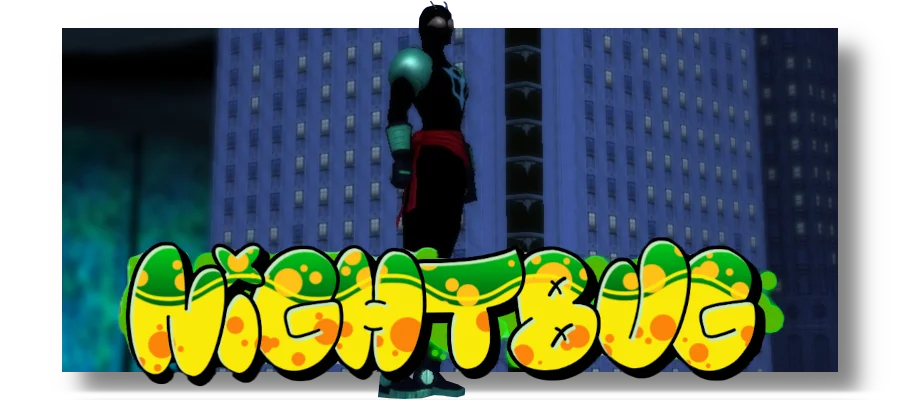
Shout out GO WHOA!
—A powerful transformation
BAM BAM into space!
—Plunge forward!
Fight!! Transform!
Go ahead and be reckless
Using the courage of the night,
—Rise up!
When stars connect
You should kiss the moon!
If you’re here,
—My dreams will surely come true
When all our smiles become one,
—The future will be won!!
“Nice suit.”
“Thanks, my mom gave it to me.”
Continue Reading →How To Be: Eda Clawthorne (in 4e D&D)
In How To Be we’re going to look at a variety of characters from Not D&D and conceptualise how you might go about making a version of that character in the form of D&D that matters on this blog, D&D 4th Edition. Our guidelines are as follows:
- This is going to be a brief rundown of ways to make a character that ‘feels’ like the source character
- This isn’t meant to be comprehensive or authoritative but as a creative exercise
- While not every character can work immediately out of the box, the aim is to make sure they have a character ‘feel’ as soon as possible
- The character has to have the ‘feeling’ of the character by at least midway through Heroic
When building characters in 4th Edition it’s worth remembering that there are a lot of different ways to do the same basic thing. This isn’t going to be comprehensive, or even particularly fleshed out, and instead give you some places to start when you want to make something.
Another thing to remember is that 4e characters tend to be more about collected interactions of groups of things – it’s not that you get a build with specific rules about what you have to take, and when, and why, like you’re lockpicking your way through a design in the hopes of getting an overlap eventually. Character building is about packages, not programs, and we’ll talk about some packages and reference them going forwards.
We’ve talked about The Owl House before in this column, and last time it was about the incredibly cool Made Of Love Interest Amity Blight. But that’s not all that The Owl House offers for cool and interesting character inspiration you should totally use as an excuse to get onto the table in your friendly 4th Edition D&D game –
You do have one of those right?
Why are you reading these then?
Spoiler Warning: I’m going to mention things that happen in The Owl House that change the status quo. If you want to avoid that kinda thing, this is your warning!
Continue Reading →Game Pile: The Beginner’s Guide, Midjourney, and Praying to Coda
This is a rebuild and expansion of my article on The Beginner’s Guide from back in 2018, with a newly developed thesis about authenticity and access to artists.
Continue Reading →Paradox Pokemon (But Just the Dinosaurs)
I think it’s fair to say that at this point in my life I have fallen out of interest in actually playing Pokemon games. The last one I finished was Pokemon Sun & Moon, which I thought was excellent! I didn’t finish Sword & Shield, and I think that’s mostly because the game is full of guardrails and reminders that are designed to keep the game playable for a four year old who may be learning to read, and in the process plays very slowly compared to how I want to play games. I do know enough about the game to think that most of the criticism of Pokemon as a franchise is at the very least, weird, if not outright bad faith nonsense.
Despite all this though, I love looking at Pokemon. I love watching streamers play it, and I love watching strategy reports from the real competitive scene. I am, for lack of a better word, a spectator. A fan.
This last generation of Scarlet & Violet, has brought with it something that I’ve wanted for so long, and never really formally been able to express. Thanks to time travel shenanigans – oh, spoilers, I guess? – this is the generation where we get to see Pokemon’s dinosaurs.

Goblin, Vandal, Sugg
Every word you’ve ever used comes from somewhere. The structures you use to discuss ideas is informed by ideas that came before it. I’m not getting all Sapir-Worf about this (and if you don’t know what that is, you don’t have to know because it’s probably not true), but rather wanting to draw your attention to the way the world you live in is in part defined by the words you use. If you’re an English speaker, there are ways you describe food that are a byproduct of French invasion centuries ago. Words like ‘technocrat’ and ‘hyperspecialised’ are constructions that borrow from how intellectuals used to use Latin. Your swear words are almost all from the poor working class, and used to describe sex, god, or excrement, and that’s not how all swear words work in all cultures!
Your world shapes your language.
In any given fantasy setting you work on, you don’t usually have the same linguistic history to justify why the people there talk like we talk now. In fact, to be completely fair, they probably don’t talk like us at all: you have fantasy languages, across fantasy constructions. Any given phrase a character in your world says is probably not using the exact same words as we are and we’re all working with a sort of fictionalised fantasy that makes the concepts reasonably translate across.
There’s a whole treatise then about how we handle Native American names and loanwords that we italicise like etouffee.
Point is that you have words, in your world, and you can attach stories to them. You’ve probably seen me talk about Orcs and how they relate to language and stereotypes, along in my long post on the word ‘Orc’. Here’s another set of examples I like for my world of Cobrin’Seil, as they pertain to the best little evolved raccoons, the Goblins.
Continue Reading →Game Pile: Marvel United (Core)
CMON raised two million dollars to make a cooperative Marvel game that absolutely did not need miniatures, but got them anyway, and made them really kickass looking big-headed chibi miniatures. The game is fine. The game is perfectly tolerable. You can make a better game looking at it. Let’s look at it.
Continue Reading →MTG: Propagator Primordium
I can’t stop thinking about this card.I am sitting up late at night and trying to imagine something to write about and the only thing that keeps coming into my mind as a thing to write about at all is, well, this card.
This one card.
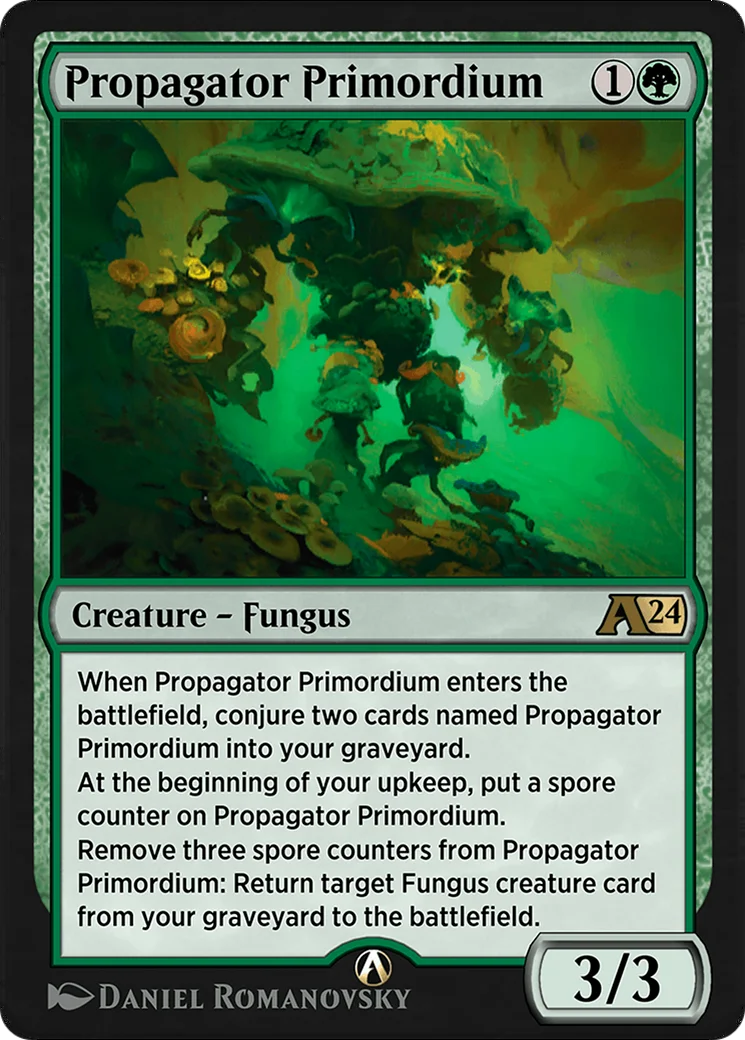
4e: Many Hands Make Fight Work
Yeah I’m stretching for an aphorism, don’t @ me.
There’s a term you may have heard in the context of tabletop games, usually in the context of combat-focused tactical games, but not always, and sometimes in the context of videogames or TCGs, which is the idea of Action Economy.
But what is, an action economy?
Continue Reading →Game Pile: Ten Things I would Have Liked To Know When I Started Magic Arena
Thumbnail and outline below the fold!
Continue Reading →The Yawning Boredom Of The Word Epic
Good god this is a dull word, right?
Cancon was a fun convention, I liked it a lot. But while I was there, I saw this word being worn into a groove in my brain. It was an all-purpose descriptor, a vague and generic positivity, a detailer of scope and an encouragement for engaging, and every time I saw it I felt a bit of my brain shut down in response. I think some of this is just the normal overuse of meaningless words. If someone described a game as being ‘lit’ I would probably also just as much immediately ignore that descriptor. Packing peanut language, that kind of thing.
And I know it’s rich, coming from me to complain about overuse of cliche. I just said ‘packing peanuts’ which is something I am very selfconscious about saying a lot.
It’s not just the ungoogleable game Epic by Wise ‘Maybe We Don’t Want To Be Called White Wizards Any More’ Wizards. It’s also games like Epic Spell Wars of the Battle Wizards: Duel at Mt Skullzfyre or Epic Resort or Tiny Epic and their franchise of genuinely exciting little games, or Crafting Epic Dungeons or Epic Scenery or Epicness Incarnate or Warhammer Epic or Epic Confrontation and you might not know if I made any of these games up, or all the other things I saw on the convention floor that just kept using the term, and every single time made me realise that in so doing, I now knew less about them than I would if almost any word was in that space.
What is ‘epic’ for?
Continue Reading →Bloodwork Update 11
Oh snappers it’s another one of these, and yes, I have not forgotten about Bloodwork even if I’m writing this two hours before it goes up!
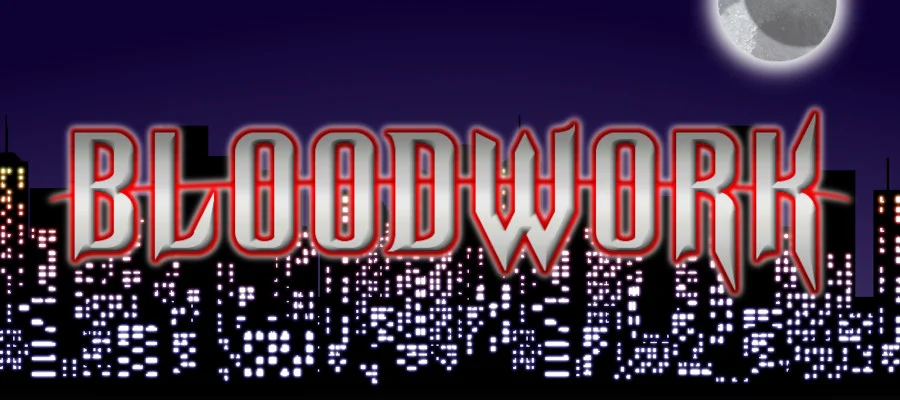
Playing For Money
Hey if a game is the consensual overcoming of unnecessary obstacles, are people still playing a game if they’re being paid to play?
What if the game does not have money as part of the game?
What if being seen as playing the game is incentivised?
Is capitalism fundamentally violent?
Sure let’s start it off with some easy questions.
Continue Reading →Vox Maxima Story Spotlight 2 — College Days
What follows here is a discussion of what, if I had the means and writer tools to make my Custom Magic set have proper story spotlight material, it’d look like this, it’d be built out of this. This is basically about story mechanics underlying a game system, and I want to present it to you so you can have a handle on what it looks like when I’m trying to explain game narratives for the presentation of conventional narratives.
This second section is about the characters travelling through the Kraivh highways to the city that holds the Iacon College
Vox Maxima is a custom magic set created by Talen Lee. It’s composed of 187 cards, with 71 commons, 60 uncommons, 41 rares, and 15 mythic rares. Vox Decima is a custom Magic: The Gathering set, with at least one card spoiled a day, on Cohost, Kind.Social, and the r/custommagic subreddit.
WOTC Employees: This post in full presents unsolicited custom Magic: The Gathering card designs, which I understand current employee practices forbid you from looking at unsolicited. You shouldn’t be here!
Continue Reading →